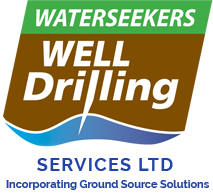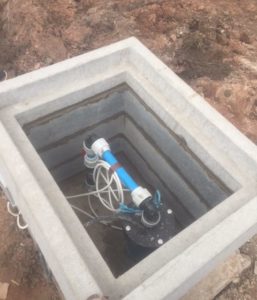The most visible portion of your drinking water system is the wellhead, the structure built over your borehole to protect its various parts. By protecting your wellhead, you will ensure the quality of your drinking water supply.
Maintaining Your Well-head
The well-head protects the well casing, which is the lining of the borehole, and the borehole cap, which provides a tight-fitting seal at the top of the borehole. The wellhead is your first line of defence to prevent pollutants from penetrating your drinking water system. Inspect your wellhead regularly to make sure these elements are in good condition.
To keep your borehole safe, ensure a borehole professional performs any new borehole construction or modification, or to close an old borehole.
Take care when working or mowing around your borehole. It is easy to damage the well-head with heavy equipment, which will jeopardise the sanitary protection of your well, permitting contaminants to enter the water supply. Don’t pile snow, leaves or other materials around the borehole, where they can carry pollutants into the system.
When landscaping around your borehole or siting a new borehole, make sure the top of the borehole sits at least one foot above the ground. Slope the ground down and away from your borehole for proper drainage.
Ensure Clean Drinking Water
Some common household activities can actually threaten the quality of your drinking water. Even small spills of pesticides, fertilisers or fuels near your borehole can seep into the ground and contaminate the water.
Avoid mixing or using pesticides, fertilisers, herbicides, degreasers, fuels or other pollutants within 100 feet of your borehole. When siphoning water for these tasks, be careful to avoid back-flow back into the borehole system.
Conduct a quick visual check for activities that might threaten to enter your drinking water system at or near the wellhead which may include the following: septic tanks, lateral fields, cesspools, chemical storage areas, machinery maintenance areas, waste piles, sewers; underground storage tanks for chemicals, fertilisers, or petroleum products, above-ground tanks for chemicals, fertilisers or petroleum products; animal pens or feedlots and manure storage areas.
If your existing well is located near these activities, you may need to test your water quality more often than once a year. Try to move the risky activities away from your well. Check that your well is located on your property according to standards set in your area. These regulations are designed to protect the integrity of your water supply.
You should also inspect and pump septic systems on your property as often as recommended by your local health department or septic service, usually at three to five year intervals. Failing septic systems can leach contaminants into the water supply.
Waterseekers Drilling Company Ltd
If you would like to talk to us about your water well maintenance, we are happy to give advice. Use the contact form, or call us on 01246 938499
In the meantime, thanks for reading!
Jenny Hormell
Director
Waterseekers Well Drilling Services Ltd.
Post on 04 Aug 2017 by Jenny Hormell
Posted in
- borehole maintenance
- borehole maintenence
- looking after your water borehole
- looking after your waterwell
- maintenance manual
- maintenence manual
- water bawholes
- water borehole care
- water borehole maintenance
- water borehole maintenence
- water borholes
- water borrholes
- water well maintenance
- water well maintenence
- waterwell care
- waterwell maintenance
- waterwell maintenance manual
- waterwell maintenence
- waterwell maintenence manual
- waterwells
- watr boreholes










